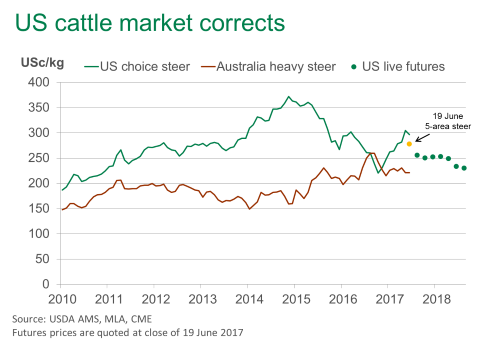Are US cattle prices past their peak?
US cattle prices declined over the past week. Last Monday, the choice steer (five-area negotiated sales) was 136¢/lb lwt; the same indicator closed yesterday at 126¢/lb lwt. Futures markets have eased by a similar magnitude.
Rallying US prices in the first half of 2017 surprised some onlookers, as the US cattle herd recovered much faster than most anticipated. The rise in US cattle prices was associated with a range of factors: reduced imports from Australia and NZ; growing exports to Japan and Korea; poor weather impacting fed cattle weights (and beef production); declining cattle prices in 2016 leading many retailers to increase beef promotions, stimulating demand; and many end-users finding they were short leading into key grilling season holidays.
So, are US prices past their peak? The futures market thinks so, as illustrated below.

Where does this leave the Australian market?
Historically, US and Australian cattle prices are correlated – underpinned by the two suppliers sharing a range of markets (Japan, Korea and the US domestic market). Typically, the US choice steer averages a 40% premium to the Australian saleyard heavy steer, on a currency adjusted basis, however the two markets can break free of this historical relationship (case in point 2014 and late 2016).
The latest USDA World Agricultural Supply and Demand Estimates (WASDE) forecast the world’s largest beef producer, the US, to expand production by 4% in 2017. This additional beef will continue to provide strong competition against Australian product.
If Australian heavy steers were to follow the historical discount (40%) to prices implied by the current US futures market, this would place the indicator closer to 200A¢/kg lwt towards the end of 2017 (assuming a Australian dollar of 75US¢). Ongoing tight slaughter cattle supplies in Australia will mitigate the indicator dropping that low, but the Australian cattle market will continue to face competitive pressure from the US.



